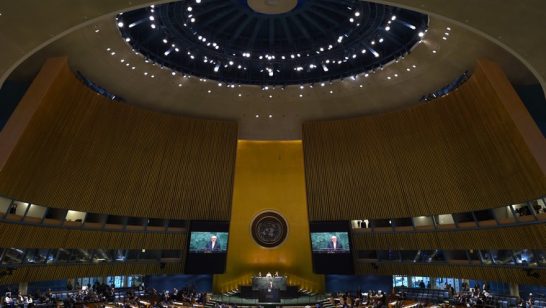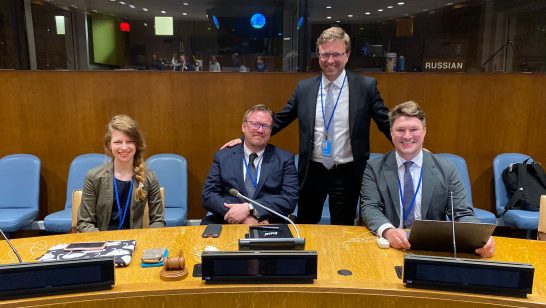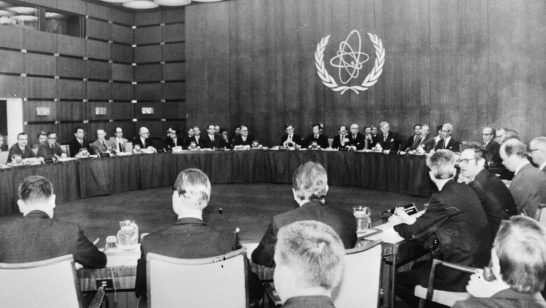
In many ways, the NPT is a success story: It has been a highly effective instrument in preventing and delegitimising nuclear proliferation (pillar 2) and establishing and controlling peaceful uses of nuclear energy (pillar 3). However, the disarmament pillar (pillar 1) is discernibly lagging behind the other two. This endangers the overall success of the NPT as its three pillars, although separate, remain interdependent and interlinked.
This known disbalance between the pillars was most recently laid bare at the 10th NPT RevCon in August 2022. Adding to an already deteriorating international security environment and the fundamentally polarised perspectives on the feasibility of disarmament, the unjustified Russian war of aggression against Ukraine that began in February 2022 has exasperated the challenges that the NPT regime is facing. Although the disarmament pillar had made little progress even before the war, Russian rhetoric, behaviour, and actions over the last year have undermined the norms underlying and strengthening the NPT regime. As the progress in this pillar is stagnating, disarmament needs special attention in this review cycle until the 11th RevCon in 2026.
Although the disarmament pillar had made little progress before the war, Russian rhetoric, behaviour, and actions over the last year have undermined the norms underlying and strengthening the NPT regime. Maren Vieluf
Considering the significant and highly dangerous increase in the risk of (un-)intended nuclear weapons use, it’s paramount not to lose sight of disarmament and the goal of a world without nuclear weapons. Building up nuclear arsenals cannot be the solution, and the case for nuclear disarmament is stronger than the one for (re-)armament and deterrence. The world does not want a global nuclear arms race. Progress on nuclear risk reduction and transparency measures should be vital to shaping the global security environment into one that will allow nuclear disarmament as envisioned in the NPT. Not only as an end in itself but also as an interim success and stepping stone towards fulfilling disarmament obligations. Risk reduction is where the NPT member states can and should make progress now.
Disarmament in the NPT regime
The NPT’s grand bargain includes and hinges on all pillars: non-nuclear weapon states (NNWS) enjoy the benefits of peaceful uses while promising not to develop or acquire nuclear weapons themselves, while the five nuclear weapon states (NWS) – who are also the five permanent members of the UN Security Council (the P5) – support the NNWS in these endeavours. At the same time, all member states – with a special focus on the NWS – are obliged “to pursue negotiations in good faith on effective measures relating to cessation of the nuclear arms race at an early date and to nuclear disarmament, and on a treaty on general and complete disarmament under strict and effective international control” (Art. VI of the NPT).
After the indefinite extension of the NPT in 1995, both the 2000 and 2010 Final Documents formally strengthened the commitments to disarmament and were aimed at underpinning the Art. 6 obligations with concrete measures. Despite this, the number of nuclear weapons in the world has not been reduced through the NPT mechanisms, nor has there been a decline in their role in the defence and security strategies of NWS. Nuclear weapons have yet to be delegitimised as envisioned. Instead, the status quo of a two-tier split between NWS and NNWS is being solidified as NWS are not fulfilling their Article VI obligations. They are not only keeping their arsenals but are even modernising and expanding them due to either ingenuity and/or an unwillingness to deliver on their promises. With states at odds on the “urgency, method, sequencing, and relationship with other strategic issues” of this disarmament obligation, the disarmament pillar hinges on the willingness of the NWS and, as a result, lies idle.
Complicating matters further, there is also a numerical divide within the P5 states that hinders joint measures. As the United States and Russia possess more than 90 percent of the world’s nuclear weapons, they are responsible for leading the way enshrined in agreements among NPT states parties. Reductions in the arsenals of these two actors are mainly associated with unilateral cost-benefit calculations and evaluations of what is necessary and sufficient for defence purposes.
The lack of implementation of and commitment to Article VI obligations endangers the NPT as it challenges overall compliance and erodes hard-won nuclear norms. The UN Treaty on the Prohibition of Nuclear Weapons (TPNW) reflects the dissatisfaction of many NNWS. While there can be no disarmament without the nuclear weapon states, there is no visible progress on disarmament with or by them. The TPNW, therefore, allows NPT member states to enrich the dialogue on nuclear weapons with a perspective that is often overlooked: the humanitarian consequences of any nuclear weapons use and the cost of nuclear deterrence—something the world is currently confronted with in the war in Ukraine.
Risk reduction as a priority
The 2022 NPT RevCon solidified these differences and the lack of agreed-upon concrete steps for working towards nuclear disarmament. It is, therefore, now time to infuse this pillar with fresh impulses and ideas and revisit and revive ideas already out there, with risk reduction being the most urgent. Risk reduction is the key to keeping the disarmament pillar alive. Not only short- but also medium- and long-term measures are needed. Reducing and eliminating nuclear risks is a common interest. Still, the first and critical hurdle to overcome is the willingness to kick-start the discussion on risks, risk reduction, and risk reduction measures, mainly amongst the P5 but also in the wider context of both the NPT and potentially with other nuclear-armed states who aren’t yet members of the NPT.
It is now time to infuse this pillar with fresh impulses and ideas and revisit and revive ideas already out there, with risk reduction being the most urgent. Risk reduction is the key to keeping the disarmament pillar alive. Maren Vieluf
The ‘subjectivity’ of nuclear risk and the different interpretations of definition and scope have hindered finding a common understanding of risks – which would be the foundation of any risk reduction steps. Risk reduction is also misused to ensure the credibility of deterrence and not as a tool for arms control and disarmament. Nuclear deterrence is dependent on the credible threat of nuclear weapons use and often paired with strategic ambiguity of nuclear use scenarios, while risk reduction measures often aim at reducing ambiguities. While NPT states parties tend to agree that risk reduction is neither a precondition nor a substitute for nuclear disarmament, there is an observable mismatch between words and actions.
The war in Ukraine and the nuclear threats by Russian officials have a variety of implications for any risk reduction endeavours and the NPT review process as a forum for progress. The risk of nuclear weapons use has not been this high in decades, and Russia uses nuclear threats to push through its imperialist agenda. The invasion shows that a P5 member state, an ‘accepted’ NWS entrusted with safeguarding peace and security via the UN Security Council, can disrespect and break international law, treaties, and norms. The ink was not yet dry on both the P5 working paper on strategic risk reduction from December 2021 and the P5 reiteration of the Reagan-Gorbachev-Formula that “a nuclear war cannot be won and must never be fought” from January 2022, when Russia invaded Ukraine.
Risk reduction is understood as the management of risks associated with nuclear weapons and, more specifically, the prevention of nuclear conflict and any nuclear weapons use. The facets of use, either doctrinal, rhetorical, escalatory, accidental, unauthorised, or inadvertent, have received significant attention in the past decade but have earned a new urgency. To step back from the brink of nuclear escalation, Russia must stop using the inherent risks of nuclear weapons to support its war of aggression. The NPT member states need to find implementable, ambitious but achievable, holistic, interlocking, mutually reinforcing, adaptive, tangible, and sustainable tools and measures to reduce the risks of nuclear weapons use. These hinge on the political will of all states and need to be mutually beneficial while enabling verification measures to be trusted tools.
The NPT risk reduction agenda
Dialogue is the first step toward risk reduction. The NPT Preparatory Committee meetings (PrepComs) leading up to the next RevCon and the P5 workflow are essential in this regard. Other initiatives, such as the 22 Stepping Stones formulated by the Stockholm Initiative and the US-led working group on Creating the Environment for Nuclear Disarmament (CEND) – especially subgroup three on risk reduction – will be needed to create a feasible but ambitious risk reduction agenda to help build an avenue to reducing risks, as well as arms control and disarmament. Initiatives and suggestions by NNWS, as well as civil society and academia, are important building blocks of a common strategy to reduce nuclear risks.
This agenda should include dialogue on risks, misperceptions, and misunderstandings to build a common understanding of risks and measures to reduce them in the first place. Confidence-building and transparency measures, crisis prevention, and management tools, including hotlines and risk reduction centres, are known and effective measures to expand. Further measures of de-alerting and de-targeting, as well as refraining from launch on warning (LOW) policies by the US and Russia (allowing instant retaliatory nuclear strikes in case of detection of a missile strike), should also be explored. Statements and declarations on nuclear policy and limits on certain weapons that could lower the nuclear threshold should also be included.
Existing tools and measures should be revisited and audited to deal with the ambiguity of treaty obligations, norms, and declaratory policies. The relationship between conventional risks and those risks arising from new tech needs to be explored. Unilaterally, NWS can do a lot to reduce risks and positively inspire others, including no-first-use or sole-purpose statements that would need to be reflected in a declaratory policy and force structure adaptations.
A step-by-step approach to disarmament is the only feasible way to reduce nuclear weapons, but it needs mutual reassurance, trust, coordination, and fulfilment of these steps. Maren Vieluf
A step-by-step approach to disarmament is the only feasible way to reduce nuclear weapons, but it needs mutual reassurance, trust, coordination, and fulfilment of these steps. Due to growing geopolitical tensions, concrete risks of nuclear escalation in the war against Ukraine, and a re-commitment to armament and deterrence, this seems unlikely today – which makes it more critical than ever. Waiting for the right security environment instead of creating it and the lack of commitment to maintaining existing, and building new, risk reduction measures also have a hand in the perceived increase in risks. NWS must step up and work tirelessly on risk reduction to fulfil their NPT commitments.
The opinions articulated above represent the views of the author and do not necessarily reflect the position of the European Leadership Network or all of its members. The ELN’s aim is to encourage debates that will help develop Europe’s capacity to address the pressing foreign, defence, and security policy challenges of our time.
Image: Flickr, Kelly Michals



